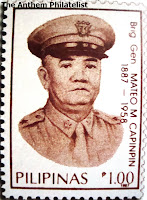Vicente López y Planes on Stamps

The Argentine National Anthem (Himno Nacional Argentino) is the national anthem of Argentina. Its lyrics were written by Vicente López y Planes, and the music was composed by Blas Parera. This song was adopted as the national anthem on May 11, 1813, three years after the "May Revolution" (Revolución de Mayo); May 11 is therefore Anthem Day in Argentina.
On May 24, 1812, Vicente López attended a play presented at the Casa de la Comedia, Buenos Aires, titled El 25 de Mayo, which retold the story of the May Revolution that happened two years earlier. The play, written by Luis Ambrosio Morante, concluded with an anthem sung by the actors. López felt inspired and that same night wrote the first verses of an anthem that would replace Morante's, for which Blas Parera had composed the music.
The General Constituent Assembly, the autonomous government of the time, approved the new anthem as Marcha Patriótica (Patriotic March) on May 11, 1813, and commanded Parera to compose a new music. Some authors say that Parera accepted, but after many days no result was presented. Finally, he refused, being a Spaniard himself, as the lyrics were offensive to Spain, and he feared the reaction of the King. He was jailed by the Assembly and forced to compose under threat of execution. In a single night he finished the partiture, by simply copying the musical score he had composed for the theatre play. He was then released and later he abandoned the country forever, living for many years at Rio de Janeiro and later in Spain, where he died.
The finished song was first played on May 14, 1813 at the home of the aristocrat Mariquita Sánchez de Thompson, and presented publicly on May 25 of the same year. It was then known as Canción Patriótica Nacional (National Patriotic Song), and later simply as Canción Patriótica (Patriotic Song), but in an 1847 copy it appears under the title Himno Nacional Argentino, retaining that name until today.
In the complete version of the Anthem of May (as was christened by López) it is noted that the political vision portrayed is not only Argentine, but Latin American. The lyrics are burningly independentist and anti-Spanish, as the country was at that time fighting for its independence from Spain. The anthem suffered a modification in 1860, commended to the musician Juan Pablo Esnaola, who arranged a more orchestrated and harmonically richer version of the original music.
Blas Parera (1777 – 1840) was a Spanish music composer. He lived his part of his life in Buenos Aires. He was born in Catalunya, Spain and, in 1797, he moved to Buenos Aires. He contributed in the defence of the port of Buenos Aires during the British invasions of the Río de la Plata. He composed the music of the Argentine National Anthem, written by Vicente López y Planes in 1813; it was known as the Marcha Patriotica. He went back to Spain briefly after, and died in Mataró on 7 January 1840. He was also a music teacher.
Alejandro Vicente López y Planes (May 3, 1785; Buenos Aires - October 10, 1856) was an Argentine writer and politician who acted as interim President of Argentina from July 7, 1827 to August . López was a member of the Constituent Assembly of year XIII, representing Buenos Aires. At the request of the Assembly, he wrote the lyrics to a "patriotic march", which eventually became the Argentine National Anthem. It was a military march, whose music was composed by the Catalan Blas Parera; it was approved on March 11, 1813. The first public reading was at a tertulia on May 7 in the house of Mariquita Sánchez de Thompson. It displaced a different march, written by Esteban de Luca, which would have been the hymn if not for the more militaristic Lopez.

López participated in the government of Carlos María de Alvear, and with his fall he was sent to prison. He held a few more public offices, and was then named Secretary of the Constituent Congress of 1825, and, a little later, minister for the president Bernardino Rivadavia.
After the scandal of negotiations with the Brazilian Empire, Rivadavia resigned the presidency. In his place, López was elected as caretaker, signing the dissolution of the Congress and calling elections in Buenos Aires. The new governor, Manuel Dorrego took charge of the ministry; this unified the federalists. When Dorrego fell from grace and was executed by firing squad by Juan Lavalle, Lopez was exiled to Uruguay. He returned in 1830 as a member of the Tribunal of Justice for Juan Manuel de Rosas. He was president of the Tribunal for many years and, among other things, presided over the judgement of the assassins of Juan Facundo Quiroga.
He was president of the literary salon lead by Marcos Sastre, but was not part of the group known as the Generation of 37, to which belonged his two sons, Vicente Fidel López and Lucio Vicente López.
The stamp above is a souvenir sheet containing the score of the anthem. Below is a stamp of the anthem lyricist issued in 1877.






